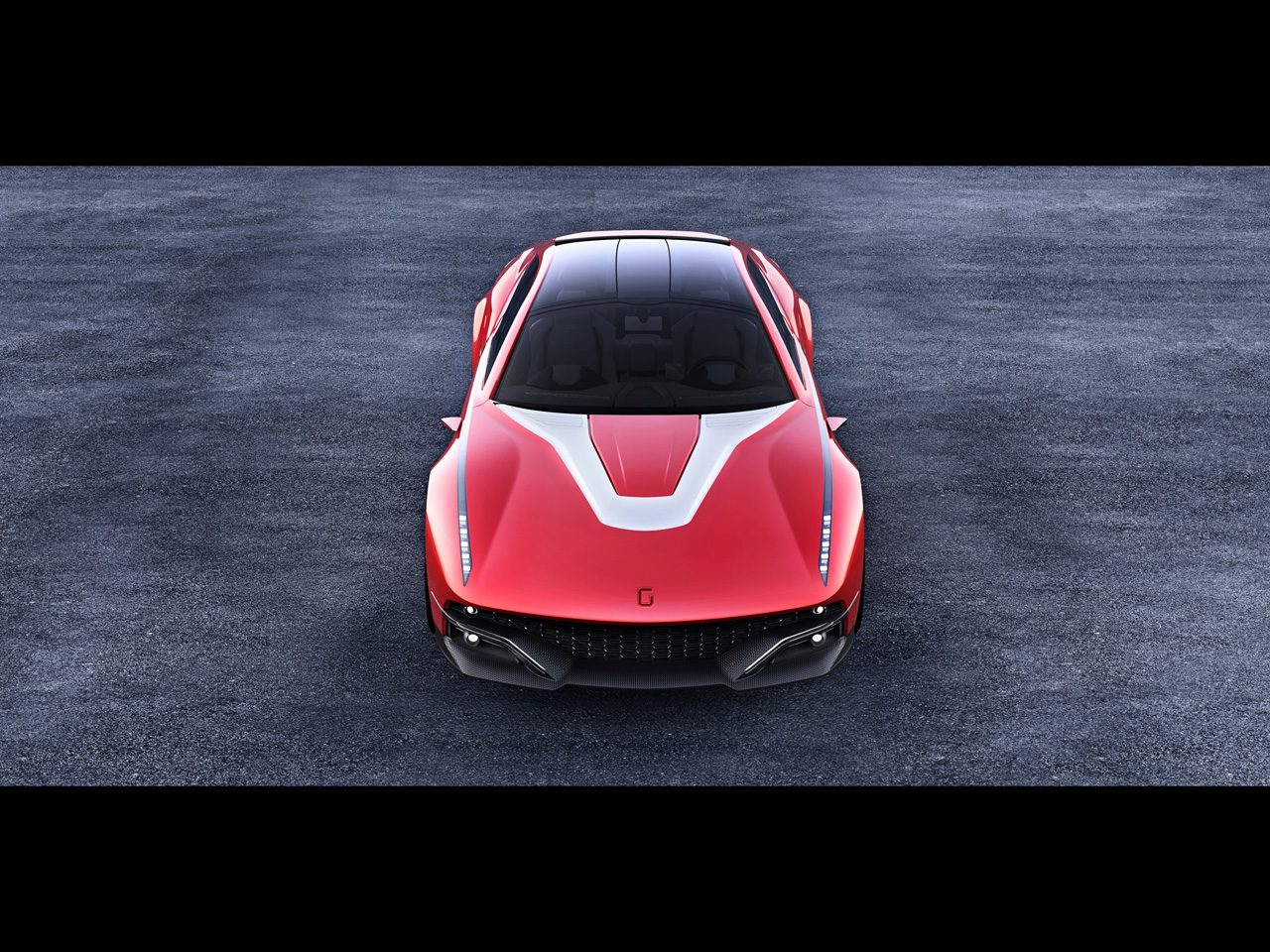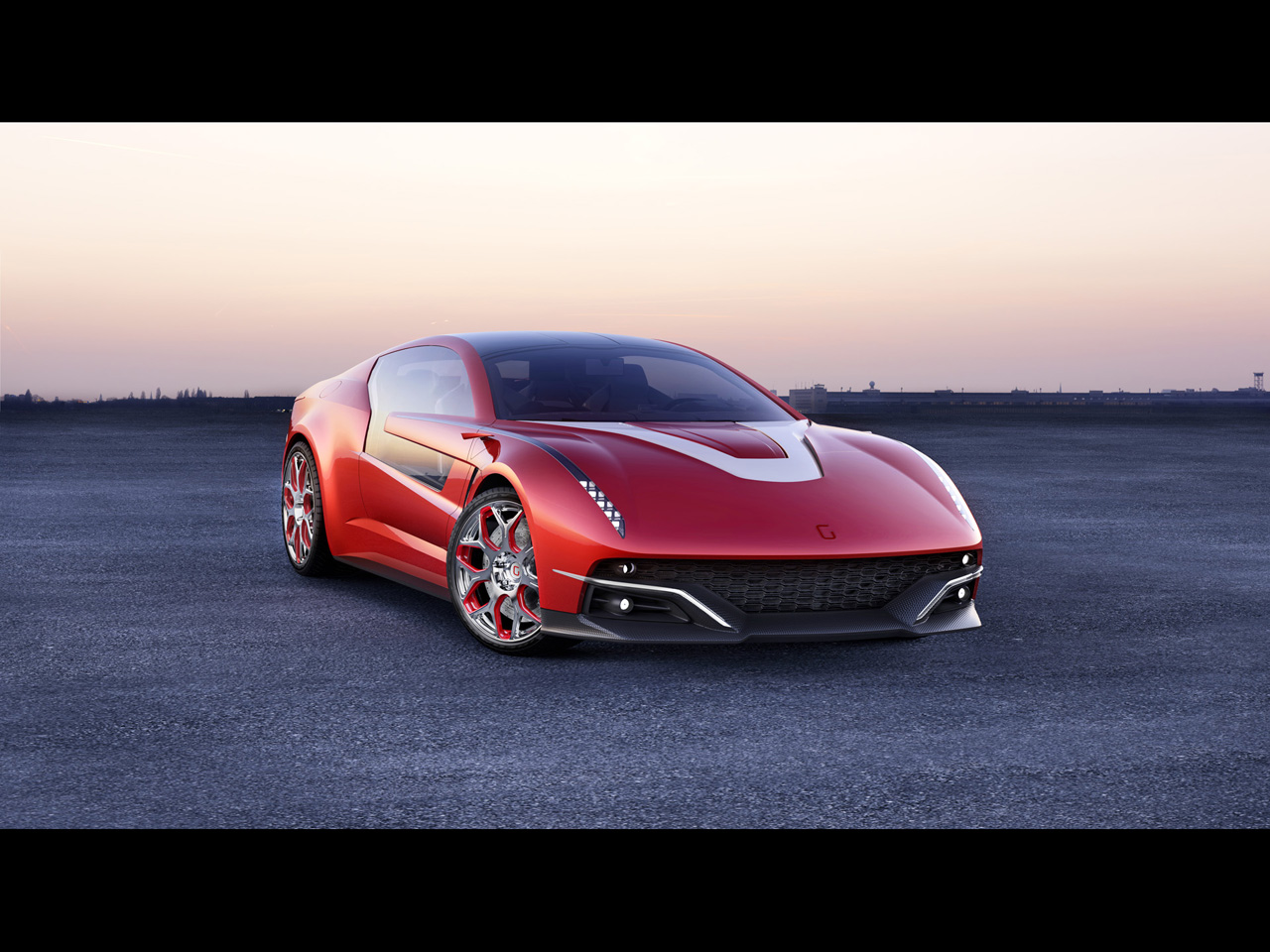2012 Italdesign Giugiaro Brivido Concept
|
Price |
-- |
Production |
-- | ||
|
Engine |
3 liter |
Weight |
-- | ||
|
Aspiration |
-- |
Torque |
-- | ||
|
HP |
360 hp |
HP/Weight |
-- | ||
|
HP/Liter |
120 hp per liter |
1/4 mile |
-- | ||
|
0-62 mph |
5.8 seconds |
Top Speed |
171 mph |
(from Italdesign
Giugiaro Press Release) Extensive research has gone into
increasing the on-board comfort of this GT, designed and produced
entirely in the company's Moncalieri factories. The vehicle offers
supercar performance, respect for the environment and the most
advanced technology and innovative solutions for a working prototype
which is ready to make its on-road debut.
For its 42nd appearance at the Geneva International Motor Show,
Italdesign Giugiaro makes the world premiere of a functional,
hybrid, four-seat prototype developed on a mechanics of the
Volkswagen Group. Capable of reaching 100 km/h in 5.8 seconds, with
a maximum speed of 275 km/h without compromising on-board comfort or
space, and inspired by technological innovation, the name of the
car-Brivido ("Thrill")-sums up its soul.
"For the last few big appearances at the Geneva Motor Show,"
explains Giorgetto Giugiaro, "I focused my research on cars that
offered great roominess with compact dimensions, and proposing
concrete solutions to concrete problems.
2012 will be an important year for us and for the Group, and with
this car we want to continue to allow people to dream and to imagine
the future. This is an exercise to show a vehicle that delivers
awesome sports car performance in an eco-friendly manner, to show
great technological content, and above all to have superb comfort.
Today true luxury is all about travelling in comfort. Following the
research into city cars, this year I wanted to test myself with a GT
which is 4.98 metres long and capable of reaching speeds of up to
275 km/h. I would not say the Brivido is a dream car-after all, this
is not an object which is destined to remain an unachievable dream.
My intention has always been to design something which is close to
industrial reality and can easily be released into the market".
Brivido was designed, engineered and manufactured in the Italdesign
Giugiaro plant at Moncalieri (Turin).
Exterior
Aluminium, carbon fibre,
and glass are the materials that define the Brivido's exterior. The
lines of the body, painted in Xirallic pearl lustre red, are sinuous
and aerodynamic and accentuate the sporty, elegant character of this
latest Gran Turismo from Giugiaro.
The windscreen, roof, rear window, and large door windows form a
glass dome that lets natural light pour into the passenger
compartment. There the occupants are surrounded by an exclusive
level of finish and high-technology, whilst they enjoy the
surrounding scenery and urban landscapes as they travel.
"This is a quest for a genuine four seater," continues Giugiaro, "to
offer comfort and visibility, especially for the rear passengers,
which is usually sacrificed in this type of vehicle. As always, I've
tried to offer solutions which can be achieved practically. The
inclusion of a pair of wide doors that rise like gull wings is the
only "exotic" concession which makes the Brivido a show car. The
rest of the solutions are perfectly applicable for vehicles destined
for the market. The rear passengers, specifically, can access their
seats without having to duck down or lower the front backrests.
Instead they can enter the vehicle easily and naturally".
The side view is dominated by the specially designed single door
which uses glass as a genuine structural element This allows all
occupants to access the passenger compartment at the same time.
The waistline hugs the curve of the wheel arch and is interrupted by
the door's side window, which in turn continues below the waistline
to significantly increase the transparent surface. As on the
Structura prototype, this feature offers the driver increased
visibility when manoeuvring as s/he can easily see the pavement to
the side of the car. At the same time this allows the rear occupants
to enjoy great outside visibility. To facilitate window-down
interactions such as toll payments, a small portion of the glass can
be lowered electronically while the rest remains fixed.
A record-breaking light cluster
Visibility is also a
watchword on the outside of the passenger compartment as the Brivido
showcases real innovation in exterior lighting. Thanks to LED
technology, the headlight clusters are not only functional, but also
represent a never-before-seen stylistic feature. Extending 2600 mm
from the front bonnet, each cluster hugs the sinuous lines of the
body and finishes midway along the side panel, at the height of the
side door. These clusters thus also act as both sidelights and
direction indicators.
"For several years now, thanks to new technologies like LEDs,"
continues Giorgetto Giugiaro, "even quintessentially functional
elements like light clusters have become something more: a
distinctive element and a design signature. With these innovative
light clusters we are confident that the Brivido will be instantly
recognizable even in the total darkness of night."
The side of the Brivido hides a final technological treasure: the
side mirrors have been replaced by an innovative system comprising
of two cameras which literally emerge from the body. When the
control is activated, the wings concealing the two micro-cameras,
positioned at the height of the side air intakes, open up 90 degrees
and activate the cameras. The camera images are then displayed on
monitors built into the steering wheel column.
From the front we are greeted with an aggressive,
ultra-technological front end. The vehicle is equipped with a single
carbon fibre panel that occupies the width of the vehicle. This
allows ample air flow to cool the engine and also acts as rear
spoiler. On top of this there are the DRL system, the driving
lights, and the fog lights.
The tail end, also in carbon fibre, flaunts two diagonal friezes
that diverge from the centre and continue along the body, housing
the rear light clusters, the brake lights, the indicators, and the
rear fog lights. As well as the rear windscreen, which offers access
to the titanium fibre covered luggage compartment, there is a small
spoiler that is activated electronically at high speeds to ensure
optimum road grip. Finally, the large side exhausts frame the
race-inspired flow deviator.
The generous surface of the bonnet, emblazoned with the inlaid "V"
in satin aluminium that contrasts with the red paint finish,
conceals a 3000 cc engine which offers 360 HP. "The satin aluminium
frieze," points out Giorgetto Giugiaro, "is not just a simple
aesthetic quirk. We have included it in order to remedy the problem
of hard spots and to achieve a lower profile. The red bonnet hides
the engine and rises in the event of impact with a pedestrian to
soften the impact. Beneath the "V" structure, we have housed
actuators directly onto the engine basement, making it an active
safety system. Here, once again, what seems like a designer's quirk,
is actually a concrete solution to a problem".
The Human Machine Interface
The Volkswagen Group Electronics Research Lab (ERL) in California collaborated with IDG to develop and build the interactive electronics and displays for the Brivido. This includes a unique docking system in the dashboard allows an iPad to be completely hidden away or, with a gesture of the hand, partially exposed to work in a "Minimal" interaction mode. The ERL also helped to create the climate and comfort controls in which the driver and passengers can access "Basic" and "Extended" features on a capacitive touchscreen. Enhancing the transition between these modes, physical buttons emerge from the control surface when needed, and hide away when not needed.
Interiors: R&D of classic materials and technological innovation
Technology, roominess,
ergonomic design, comfort, and luxury are the watchwords that
characterise the interior trim of the Brivido. The cabin offers a
genuine open space where a unique environment encases the front and
rear seats and the luggage compartment in a continuous solution,
thanks in part to the use of extremely durable and lightweight
Titan-Tex® titanium fibre.
The dashboard is structured symmetrically for both driver and
passenger. Key information is displayed on the two LCD monitors
housed inside two binnacles, one located behind the steering wheel
and the other above the iPad dock. This allows the passenger to
access the same information as the driver (journey, speed, rpm,
etc.) or manage the options for on-board entertainment.
Italdesign Giugiaro has patented its specific steering column
design. At the top of the steering column are two monitors onto
which images from the side and rear cameras are displayed. In this
way, the driver has complete control of the vehicle without ever
having to take his/her attention off the road.
The main controls are housed on two touch-sensitive panels on the
spokes of the steering wheel. The left-hand panel is used to operate
the infotainment system, the lights and the graphic interface on the
dashboard, while the right-hand panel is used to manage the climate
control system settings.
With just a simple touch, the driver can select the driving mode of
the Brivido: "Comfort" or "Sport". The dashboard on the passenger
side houses the iPad integration system.
On the tablet, the Brivido application allows the passenger to
control media, navigation, and access online content from his or her
lap. The passenger can then stow away the entire tablet in the
dashboard via an automatic mechanism or partially dock it to use as
an interface area. S/he can then control the media and navigation
content in the passenger binnacle display.
In line with the current fashion trends, the Brivido exudes an
understated elegance. For the interior furnishings, the Color&Trim
department at Italdesign Giugiaro invested in research and
development on methodologies and materials, opting for a sewing
method never used before in the automotive sector: raw cut seams.
The hides, specially produced for this prototype, are dyed in two
contrasting colours - light on the "upside" and dark on the
"backside." When it comes to seaming, the hides are bonded and raw
cut to enhance the thickness, which is otherwise usually folded
under and therefore hidden. In this way, the light-dark chromatic
contrast creates a graphic line that outlines and emphasises shapes.
The front seats are asymmetrical with a cushion overhanging the door
sill on the outer sides. This enables the occupants to get in and
out of the car with ease. Occupants sit on this "protruding wing"
and slide comfortably inside.
The sides of the rear seats house an LED system that makes entry
easier in low visibility by optically following the design of the
seats. Hiding inside are 3D glasses which make up part of the
infotainment system. Wearing them allows passengers to watch a film,
access travel information or, by connecting to the Brivido's
cameras, watch the road. The controls for adjusting the climate are
housed on a touchscreen monitor that descends from the ceiling on
request.
The tunnel accommodates the fourteen buttons that activate all the
main controls (door opening, parking brake, stability control
system, lights) and the 8-speed automatic transmission, as well as
contains the classic storage compartments and cup holders.
The display in the middle of the dashboard replicates key
information on the climate control system, fuel consumption, and the
hybrid system configuration. Depending on the graphical
configuration of the display, the buttons required to activate and
deactivate the corresponding functions emerge from the dashboard
alongside the monitor. New touchscreen technology and the experience
of high-quality rocker switches come together to create a new
control system.



